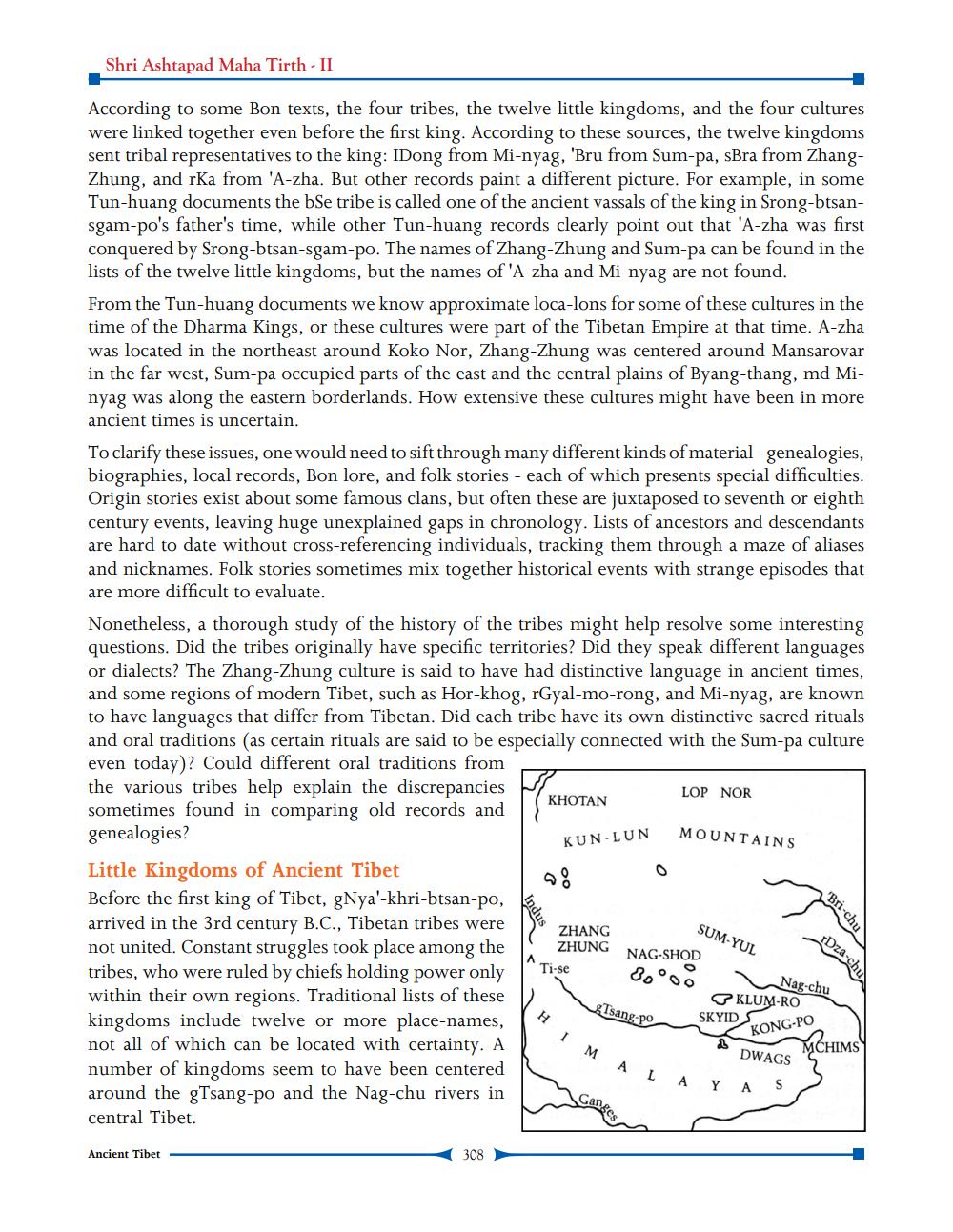________________
Shri Ashtapad Maha Tirth - II
According to some Bon texts, the four tribes, the twelve little kingdoms, and the four cultures were linked together even before the first king. According to these sources, the twelve kingdoms sent tribal representatives to the king: IDong from Mi-nyag, 'Bru from Sum-pa, sBra from ZhangZhung, and rKa from 'A-zha. But other records paint a different picture. For example, in some Tun-huang documents the bSe tribe is called one of the ancient vassals of the king in Srong-btsansgam-po's father's time, while other Tun-huang records clearly point out that 'A-zha was first conquered by Srong-btsan-sgam-po. The names of Zhang-Zhung and Sum-pa can be found in the lists of the twelve little kingdoms, but the names of 'A-zha and Mi-nyag are not found.
From the Tun-huang documents we know approximate loca-lons for some of these cultures in the time of the Dharma Kings, or these cultures were part of the Tibetan Empire at that time. A-zha was located in the northeast around Koko Nor, Zhang-Zhung was centered around Mansarovar in the far west, Sum-pa occupied parts of the east and the central plains of Byang-thang, md Minyag was along the eastern borderlands. How extensive these cultures might have been in more ancient times is uncertain.
To clarify these issues, one would need to sift through many different kinds of material - genealogies, biographies, local records, Bon lore, and folk stories - each of which presents special difficulties. Origin stories exist about some famous clans, but often these are juxtaposed to seventh or eighth century events, leaving huge unexplained gaps in chronology. Lists of ancestors and descendants are hard to date without cross-referencing individuals, tracking them through a maze of aliases and nicknames. Folk stories sometimes mix together historical events with strange episodes that are more difficult to evaluate.
Nonetheless, a thorough study of the history of the tribes might help resolve some interesting questions. Did the tribes originally have specific territories? Did they speak different languages or dialects? The Zhang-Zhung culture is said to have had distinctive language in ancient times, and some regions of modern Tibet, such as Hor-khog, rGyal-mo-rong, and Mi-nyag, are known to have languages that differ from Tibetan. Did each tribe have its own distinctive sacred rituals and oral traditions (as certain rituals are said to be especially connected with the Sum-pa culture even today)? Could different oral traditions from the various tribes help explain the discrepancies sometimes found in comparing old records and genealogies?
Little Kingdoms of Ancient Tibet
Before the first king of Tibet, gNya'-khri-btsan-po, arrived in the 3rd century B.C., Tibetan tribes were not united. Constant struggles took place among the tribes, who were ruled by chiefs holding power only within their own regions. Traditional lists of these kingdoms include twelve or more place-names, not all of which can be located with certainty. A number of kingdoms seem to have been centered around the gTsang-po and the Nag-chu rivers in central Tibet.
Ancient Tibet
308
Indus
KHOTAN
KUN-LUN
90
H
ZHANG ZHUNG
Ti-se
M
0
gTsang-po
LOP NOR
Ganges
MOUNTAINS
NAG-SHOD
800
ALA
SUM-YUL
KLUM-RO
SKYID
a
Nag-chu
KONG-PO
Bri-chu
DWAGS Y A S
Dza-chu
MCHIMS




